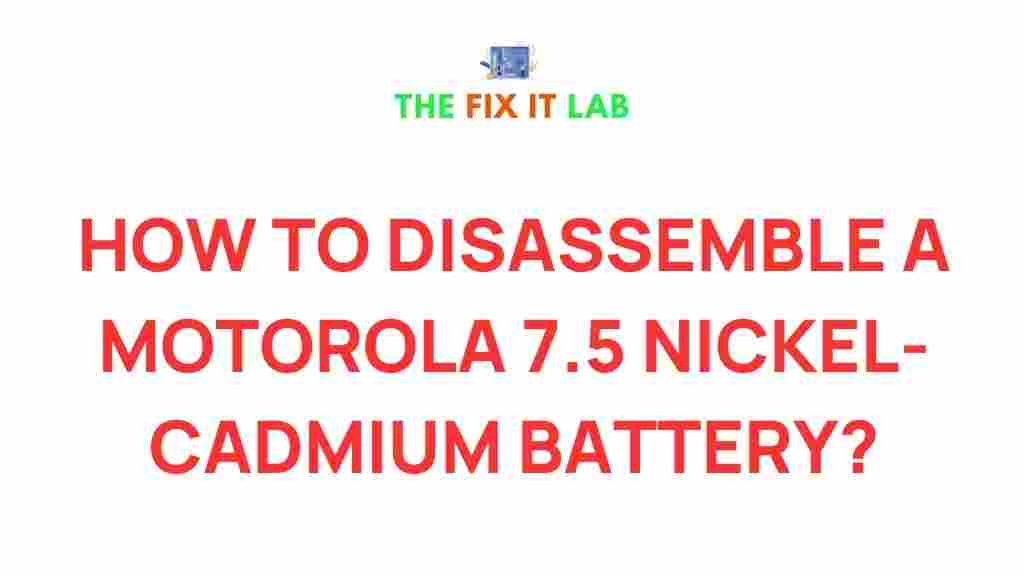Understanding the Motorola 7.5 Nickel-Cadmium Battery
The Motorola 7.5 Nickel-Cadmium battery is widely used in older communication devices due to its durability and efficient performance. However, as with any battery, wear and tear are inevitable, often requiring users to disassemble and inspect the battery for maintenance or recycling purposes.
In this comprehensive guide, we’ll walk you through the step-by-step process of safely disassembling a Motorola 7.5 Nickel-Cadmium battery. Whether you’re salvaging parts or troubleshooting a malfunction, this resource has you covered.
Why Disassemble a Motorola Nickel-Cadmium Battery?
Disassembling a Motorola battery can be essential for several reasons:
- Recycling: Properly handling nickel-cadmium batteries prevents environmental harm.
- Maintenance: Identify and repair faults like corroded connections or leaking cells.
- Salvaging: Retrieve functional cells or components for reuse.
Now that we understand the importance, let’s dive into the disassembly process.
Step-by-Step Guide to Disassembling a Motorola 7.5 Nickel-Cadmium Battery
Before proceeding, ensure you have the right tools and follow safety precautions to avoid potential hazards.
Tools Required
- Screwdriver set (preferably precision screwdrivers)
- Needle-nose pliers
- Utility knife or spudger
- Soldering iron (optional)
- Safety gloves and goggles
Safety First
Nickel-cadmium batteries contain toxic materials and can cause harm if handled improperly. Follow these safety tips:
- Work in a well-ventilated area to avoid inhaling harmful fumes.
- Wear gloves and goggles to protect your hands and eyes.
- Dispose of damaged or leaking cells at certified recycling centers.
Disassembly Instructions
- Inspect the Battery Casing:
Look for visible screws or seams on the casing. Older Motorola batteries often have plastic enclosures with clips or adhesive.
- Remove External Screws:
Using the appropriate screwdriver, unscrew all visible fasteners. Place the screws in a container to avoid losing them.
- Pry Open the Casing:
Use a spudger or utility knife to carefully separate the two halves of the battery casing. Be cautious to avoid damaging internal components.
- Disconnect the Cells:
Identify the wiring and carefully disconnect the cells using needle-nose pliers. For soldered connections, use a soldering iron to desolder the terminals.
- Inspect Internal Components:
Check for corrosion, leaks, or other signs of damage. Note any faulty components for disposal or replacement.
- Store or Dispose of Components:
Separate the reusable parts from the damaged ones. Dispose of hazardous materials following EPA guidelines.
Troubleshooting Common Issues
During the disassembly process, you might encounter the following challenges:
- Stubborn Adhesive: If the casing doesn’t open easily, apply gentle heat to soften the adhesive.
- Corroded Terminals: Use a small brush and isopropyl alcohol to clean corrosion before disconnecting components.
- Broken Clips: Replace broken plastic clips with tape or other non-conductive fasteners for reassembly.
If you need detailed guidance on maintaining your Motorola battery after disassembly, check out our maintenance guide.
Reassembling and Testing the Motorola Battery
Once you’ve completed the disassembly, reassembling the Motorola battery requires careful attention. Here’s how to proceed:
- Reinsert functional cells into the casing, ensuring proper polarity alignment.
- Reconnect wiring or solder connections as needed.
- Secure the casing with screws or adhesive tape, ensuring all parts are snugly fitted.
- Test the battery using a multimeter to confirm voltage output.
Conclusion
Disassembling a Motorola 7.5 Nickel-Cadmium battery may seem daunting, but with the right tools, knowledge, and precautions, it becomes manageable. Whether your goal is to maintain, recycle, or repurpose, following this guide ensures a safe and effective process.
Remember, always handle batteries responsibly to minimize environmental impact. For further reading, explore our battery maintenance tips.
This article is in the category Guides & Tutorials and created by TheFixitLab Team
